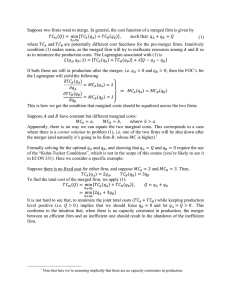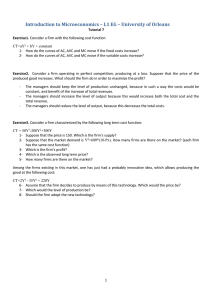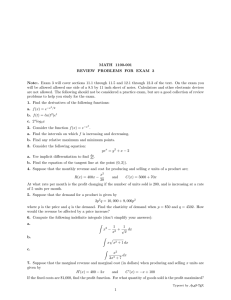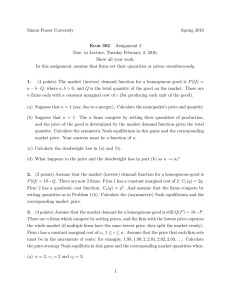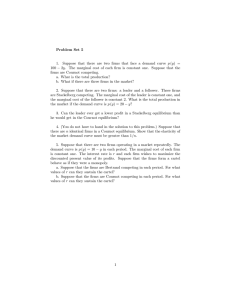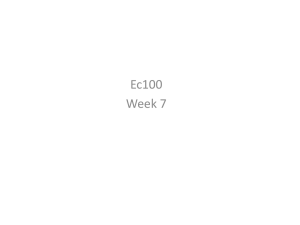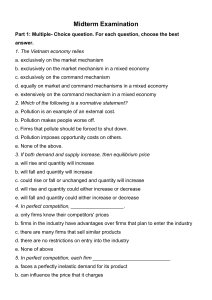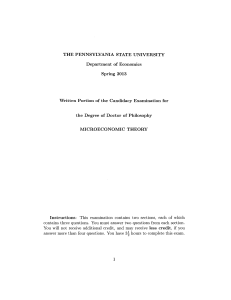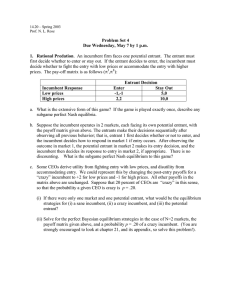Session #5 14.27 Problem Set #1. Due Question 1:
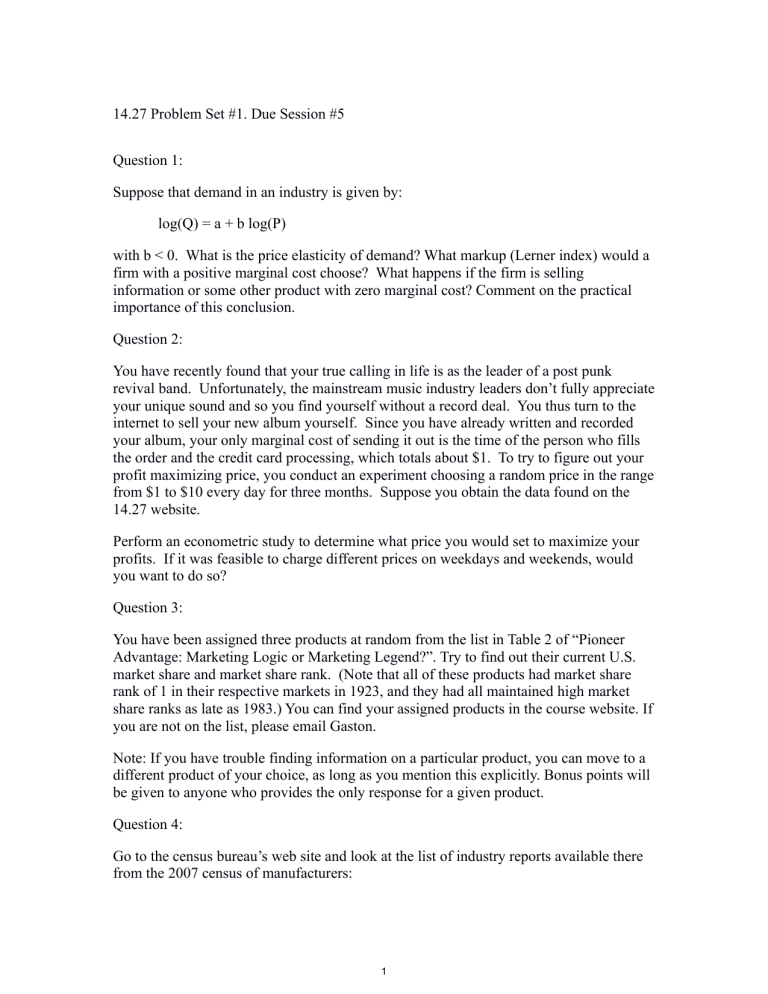
14.27 Problem Set #1. Due Session #5
Question 1:
Suppose that demand in an industry is given by: log(Q) = a + b log(P) with b < 0. What is the price elasticity of demand? What markup (Lerner index) would a firm with a positive marginal cost choose? What happens if the firm is selling information or some other product with zero marginal cost? Comment on the practical importance of this conclusion.
Question 2:
You have recently found that your true calling in life is as the leader of a post punk revival band. Unfortunately, the mainstream music industry leaders don’t fully appreciate your unique sound and so you find yourself without a record deal. You thus turn to the internet to sell your new album yourself. Since you have already written and recorded your album, your only marginal cost of sending it out is the time of the person who fills the order and the credit card processing, which totals about $1. To try to figure out your profit maximizing price, you conduct an experiment choosing a random price in the range from $1 to $10 every day for three months. Suppose you obtain the data found on the
14.27 website.
Perform an econometric study to determine what price you would set to maximize your profits. If it was feasible to charge different prices on weekdays and weekends, would you want to do so?
Question 3:
You have been assigned three products at random from the list in Table 2 of “Pioneer
Advantage: Marketing Logic or Marketing Legend?”. Try to find out their current U.S. market share and market share rank. (Note that all of these products had market share rank of 1 in their respective markets in 1923, and they had all maintained high market share ranks as late as 1983.) You can find your assigned products in the course website. If you are not on the list, please email Gaston.
Note: If you have trouble finding information on a particular product, you can move to a different product of your choice, as long as you mention this explicitly. Bonus points will be given to anyone who provides the only response for a given product.
Question 4:
Go to the census bureau’s web site and look at the list of industry reports available there from the 2007 census of manufacturers:
1
http://www.census.gov/econ/isp/
Pick two industries from the list that sound interesting. Look in the reports to see how many plants are needed to account for 50% of the industry’s output. In the table that breaks down establishments by size, look at the difference between the value of shipments and the sum of the cost of materials and wages. What does this suggest about the difference between price and marginal cost? How does this difference compare across the different sizes of establishments?
Do the two industries you picked look similar or different? If they are different, speculate about why this might be the case.
Question 5:
Suppose two firms (1 and 2) are located at opposite endpoints of a city, modeled as a line of unit length with firm 1 at x = 0 and firm 2 at x = 1. Suppose there is a continuum of consumers uniformly distributed across the line with unit mass. Consumers have utility of v i
- t d – p i
for i = 1, 2 if they purchase one unit of a product from “firm i” located a distance d away from them. They receive zero utility if they don’t purchase a product and will buy from at most one firm. Assume that both v
1 and v
2 are large enough so that consumers prefer to purchase the good in equilibrium.
A) Write down the equations that determine the demand for firm 1’s product as a function of the two firms’ prices. Use this to determine firm 1’s profit function and to find the price p
1
that maximized firm 1’s profits holding p
2
fixed. Solve firm 1 and firm 2’s profit maximization equations simultaneously to find the Nash equilibrium.
B) Now suppose that one of the firms (say firm 2) is an Internet company and therefore the consumer is not required to travel to buy the product. Thus the utility of buying from firm 2 is simply v
2
– p
2
. Repeat the steps in Part A to find the new Nash equilibrium.
Briefly discuss any similarities and differences between the equilibria.
Question 6:
Incumbent firms often undertake actions to deter or block entry. Find two specific examples of actions undertaken by incumbent firms in order to raise the fixed cost that firms must incur in order to enter a market. (Document with newspaper articles, or other sources, if possible. If not, your own recollections of markets and firm actions can be a reasonable substitute as long as they’re specific enough.) Discuss whether you consider that these efforts have been successful or not.
2
MIT OpenCourseWare http://ocw.mit.edu
14.27 Economics and E-Commerce
Fall 2014
For information about citing these materials or our Terms of Use, visit: http://ocw.mit.edu/terms .
